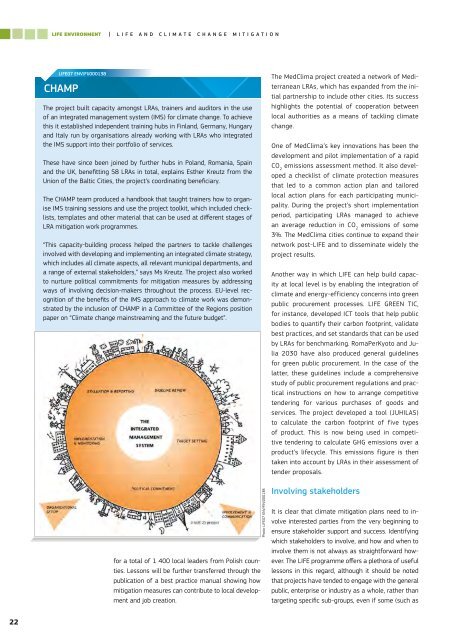Create successful ePaper yourself
Turn your PDF publications into a flip-book with our unique Google optimized e-Paper software.
LIFE ENVIRONMENT |LIFE and Climate CHANGE mitigationSnailsLIFE07 ENV/FI/000138CHAMPThe project built capacity amongst LRAs, trainers and auditors in the useof an integrated management system (IMS) for climate change. To achievethis it established independent training hubs in Finland, Germany, Hungaryand Italy run by organisations already working with LRAs who integratedthe IMS support into their portfolio of services.These have since been joined by further hubs in Poland, Romania, Spainand the UK, benefitting 58 LRAs in total, explains Esther Kreutz from theUnion of the Baltic Cities, the project’s coordinating beneficiary.The CHAMP team produced a handbook that taught trainers how to organiseIMS training sessions and use the project toolkit, which included checklists,templates and other material that can be used at different stages ofLRA mitigation work programmes.“This capacity-building process helped the partners to tackle challengesinvolved with developing and implementing an integrated climate strategy,which includes all climate aspects, all relevant municipal departments, anda range of external stakeholders,” says Ms Kreutz. The project also workedto nurture political commitments for mitigation measures by addressingways of involving decision-makers throughout the process. EU-level recognitionof the benefits of the IMS approach to climate work was demonstratedby the inclusion of CHAMP in a Committee of the Regions positionpaper on “Climate change mainstreaming and the future budget”.for a total of 1 400 local leaders from Polish counties.Lessons will be further transferred through thepublication of a best practice manual showing howmitigation measures can contribute to local developmentand job creation.Photo: LIFE07 ENV/FIN/000138The MedClima project created a network of MediterraneanLRAs, which has expanded from the initialpartnership to include other cities. Its successhighlights the potential of cooperation betweenlocal authorities as a means of tackling climatechange.One of MedClima’s key innovations has been thedevelopment and pilot implementation of a rapidCO 2emissions assessment method. It also developeda checklist of climate protection measuresthat led to a common action plan and tailoredlocal action plans for each participating municipality.During the project’s short implementationperiod, participating LRAs managed to achievean average reduction in CO 2emissions of some3%. The MedClima cities continue to expand theirnetwork post-LIFE and to disseminate widely theproject results.Another way in which LIFE can help build capacityat local level is by enabling the integration ofclimate and energy-efficiency concerns into greenpublic procurement processes. LIFE GREEN TIC,for instance, developed ICT tools that help publicbodies to quantify their carbon footprint, validatebest practices, and set standards that can be usedby LRAs for benchmarking. RomaPerKyoto and Julia2030 have also produced general guidelinesfor green public procurement. In the case of thelatter, these guidelines include a comprehensivestudy of public procurement regulations and practicalinstructions on how to arrange competitivetendering for various purchases of goods andservices. The project developed a tool (JUHILAS)to calculate the carbon footprint of five typesof product. This is now being used in competitivetendering to calculate GHG emissions over aproduct’s lifecycle. This emissions figure is thentaken into account by LRAs in their assessment oftender proposals.Involving stakeholdersIt is clear that climate mitigation plans need to involveinterested parties from the very beginning toensure stakeholder support and success. Identifyingwhich stakeholders to involve, and how and when toinvolve them is not always as straightforward however.The LIFE programme offers a plethora of usefullessons in this regard, although it should be notedthat projects have tended to engage with the generalpublic, enterprise or industry as a whole, rather thantargeting specific sub-groups, even if some (such as22


